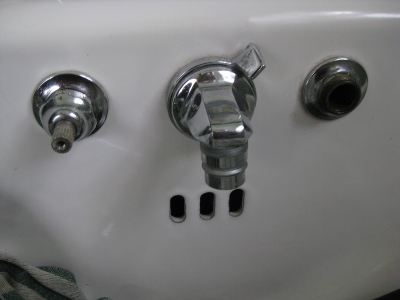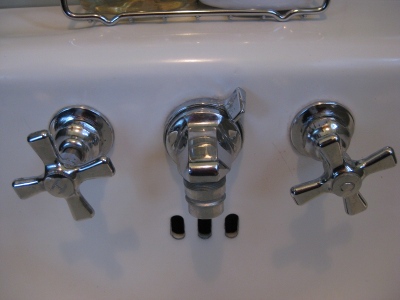Yep, it’s the third and final sink faucet unit in our living space. This one is in a very small bathroom off our kitchen pantry; it’s 1952 sink with a 1952 faucet unit. Somehow we never noticed that we didn’t have shut-off lines under it — not until the leaky faucet became too persistent to ignore, and I realized that I couldn’t conveniently shut the water off.
We had professionals come in to install the valves, and new, flexible hoses. Then I tackled the faucets. The big question was: Were they repairable? We already knew these were irreplaceable. Much to my surprise, they were less of a challenge than the unit in the upstairs bathroom, largely because I only had to work from the front.
 All I had to do to remove the stem was take the faucet handles off and unscrew the nut you see on the left. Easy-peasy.
All I had to do to remove the stem was take the faucet handles off and unscrew the nut you see on the left. Easy-peasy.
One handle was frozen to its stem, though, and the guy at our local independent hardware store bashed it off using an old screw, a screwdriver and some brute force. He didn’t have a few of the washers I needed, so I went back to the plumbing supply place where I’d gotten the faucets for the upstairs bath. They didn’t have them, either, but they knew who did — another small hardware store on the other side of town.
I remembered to take a picture of the stem before I dismantled it. There was sixty years’ worth of grit in the threads, which washed off easily with the help of a soft toothbrush. When I came back to the house, I used this picture to reassemble the stems. (An excellent trick, by the way, photograph everything. No mysteries later that way. Digital photos are also useful at the parts stores when you’re trying to explain something.)
Then it was just a matter of screwing the stems back into the sink:
This repair is not an unqualified success: Even the famous Jack LaLanne would find these handles difficult to turn, and I haven’t figured out how to change that. I seem to recall having heard that this is a common complaint about faucets of this vintage. One of the hardware store proprietors warned me to use plumber’s grease on the threads “to make them easier to turn”, which also suggests that this isn’t an unknown issue.
However, we now have water at the sink (however difficult it is to extract it), and no leaks or drips. Just to be sure, I put a bowl beneath, but so far, all is well. I seem finally to be out of plumbing projects. Now if I can only find my way to the sewing room. I know it’s around here somewhere . . .
(Useful tip: Since the washers were so hard to find, I bought a duplicate set, put them into a tiny plastic bag, labeled it, and stuck it into the mostly unused bathroom cabinet. If they need replacing, I’ve got the next set ready to go.)
Related: The Kitchen Sink and Sinking, Not Sewing



Wow, Noile, I’m super impressed with your work this post and last. I learned when I unclogged my bathroom sink by taking apart the trap (which then fell apart in my hands) that taking pix is a must (because I was going to rely on the fact that the other 2 bathroom sinks in my house are identical–they’re not!)
Soon I will have to unclog this sink again–but your post has inspired me that yes I can do something that simple again after reading you go through something so difficult!
Hey, do you want a free yellow round sew-on patch that says “Maker: 2010” on it, with a black lightening bolt? 2.25 diameter. It’s from Maker Faire. One of my friends went and gave it to me, but after reading your patch posts I think you would get more use out of it than I would.
Kyle, I have to tell you about my very first plumbing attempt in this house — something went wrong with the kitchen sink, and I went absolutely nuts trying to fix it. I fixed whatever was the initial issue, but wanted to replace the lower pipes, too. I bought a new trap, but just couldn’t figure out to install it. Fortunately, I hadn’t dismantled iteh old one when we had plumbers in for something more serious — the sewer, if I recall correctly. I had the plumbers take a look at my recalcitrant pipes — and they said “no wonder you can’t figure out how it fits — the previous plumber put it in backwards!”. Taking a picture would NOT have helped! But now, of course, I always do . . . in any case, if you can take apart a trap, faucets will pose no problems you can’t overcome!
I’d love the Maker Faire patch — thanks! I’m particularly keen as it says “Maker 2010”, which is open to all kinds of interpretations . . . (I’ll send my address to you via email.)